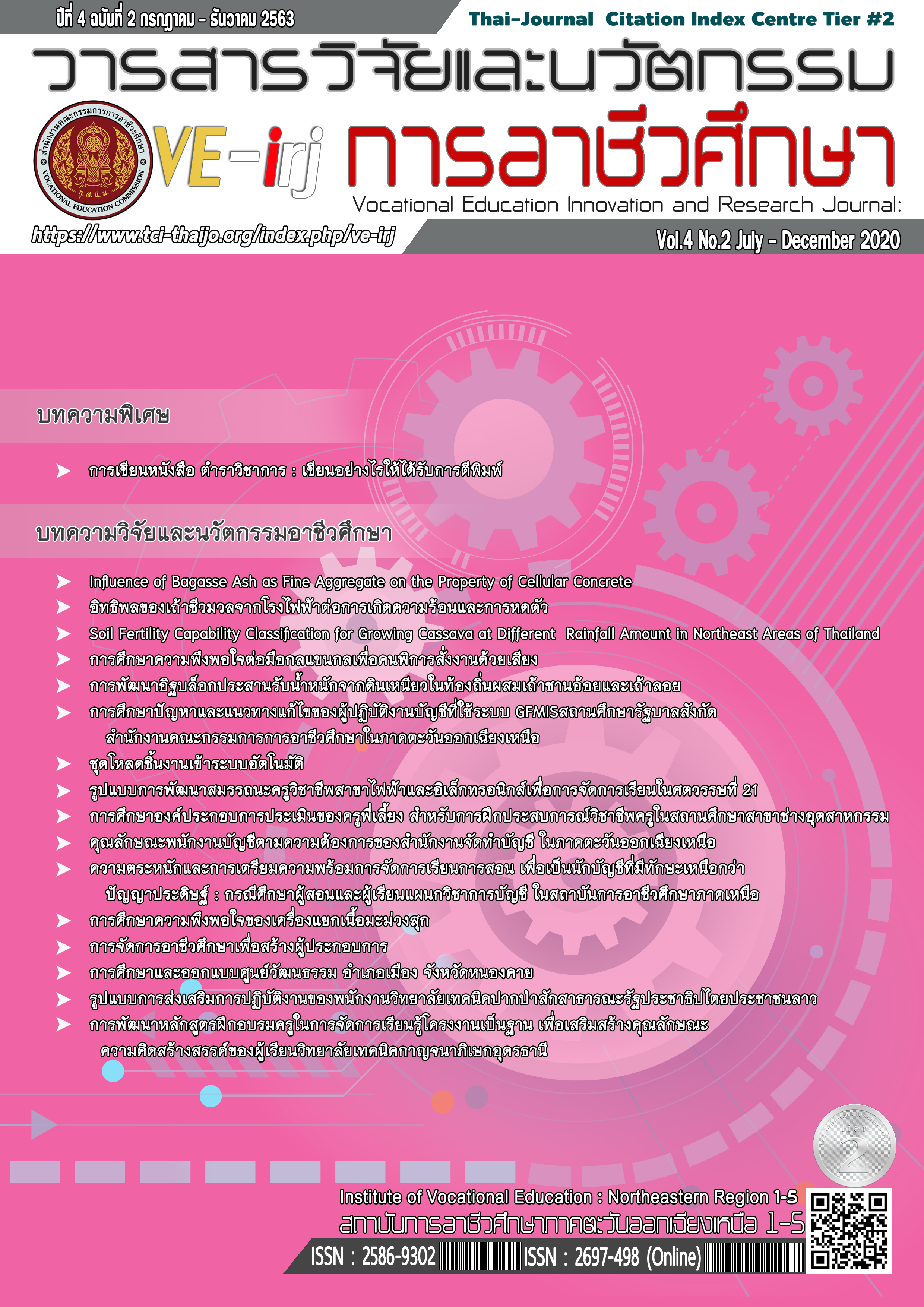Soil Fertility Capability Classification for Growing Cassava on Different Amount of Rainfall Areas in Northeast of Thailand Soil Fertility Capability Classification for Growing Cassava on Different Amount of Rainfall Areas in Northeast of Thailand
Main Article Content
บทคัดย่อ
Eight soils from cassava fields of Ubon Ratchathani and Nakhon Ratchasrima province were collected. The difference amount of rainfall in the eastern part
areas of the northeast of Thailand is higher than western part areas where cassava has been grown more intensively and for a longer period of time. Although the selected soils in this areas are classify into Typic Paleustults, the potential of soil for growing cassava might be difference. In the terms of cassava growing
and soil management practice which the period of cultivation is most important might be reflected to the recommendation subgroup of Paleustults soils. This
study aimed at investigating soil properties, fertility status and classifying the soils into FCC unit. Results revealed the soils selected were found on upper part of low terrace to middle terrace that the relief was nearly flat to undulating relief (1-6% slope). They had rather similarly well drained feature. They were slightly to extremely acid with pH ranging between 4.4-6.5. These soils contained similarly very low amounts of soil organic matter, total nitrogen and
sum bases whereas the contents of available phosphorus and potassium in the topsoil of some soils were high. CEC in the lower part of some soils was
higher than that in the topsoil while base saturation percentage being low to medium. The soils were classified almost as sandy at the Type level and loamy
in some top soils and the Substrata level in some soils. Modifiers were quite similar on strong dry season to limits year-round cropping, aluminum toxicity for most common crops, low nutrient capital reserve and high leaching potential. Interpretation of the current FCC units to indicate their suitability for growing cassava revealed only small differences in soil management schemes among the soils studied.
Article Details
สงวนสิทธิ์ โดย สถาบันการอาชีวศึกษาภาคตะวันออกเฉียงเหนือ 1
306 หมู่ 5 ถนนมิตรภาพ หนองคาย-อุดรธานี ตำบลโพธิ์ชัย อำเภอเมืองหนองคาย จังหวัดหนองคาย 43000
โทร 0-4241-1445,0-4241-1447
ISSN : 3027-6861 (print) ISSN : 3027-687X (online)
เอกสารอ้างอิง
Bruand, A., C. Hartmann, S. Ratana-Anupap, P. Sindhusen, R. Poss and M. Hardy. 2004. Composition, fabric, and porosity of an Arenic Haplustalf in Northeast, Thailand: relation to penetration resistance. Soil Sci. Soc. Amer. J. 68: 185-193.
Duangpatra, P. 1988. Soil and climate characterization of major cassava growing areas in Thailand, pp. 157-184. In R.H. Howeler and K. Kawano, eds. Cassava Breeding and Agronomy Research in Asia. Proc. of a Regional Workshop, Thailand.
Howeler, R.H. 1991. Long-term effect of cassava cultivation on soil productivity. Field Crops Res. 26: 1- 18.
Howeler, R.H. 1988. Agronomic practices for cassava production in Asia, pp.313 340. In R.H. Howeler and K. Kawano, eds. Cassava Breeding and Agron. Res. in Asia. Proc. Workshop held in Thailand.
Howeler, R.H. 2002. Sustaining cassava farmers and our earth: background of the Nippon foundation project in Asia. In Proc. of Cassava Research and development in Asia: Exploring New Opportunities for an Ancient Crop, 7th Regional Cassava Workshop, Bangkok.
Imsamut, S. and B. Boonsompoppan. 1996. Established Soil Series in the North-east of Thailand. Department of Land Development, Bangkok, Thailand.
Kheoruenromne, I., A. Suddhiprakarn and P. Kanghae. 1998. Properties, environment and fertility capability of sandy soils in Northeast Plateau, Thailand. Kasetsart J. Nat. Sci. 32: 355-373.
Maduakor, H.O. 1993. Effect of soil compaction on leaf, stem and fibrous root growth of cassava (Manihot esculenta Crantz.). Soil Till. Res. 26: 69-78.
Nakaviroj, C. 1998. Soil research and fertilizer use for cassava in Thailand. In Cassava Research and Development for Production. Rayong, Thailand.
Noble, A.D., S. Ruaysoongnern, F.W.T. Penning de Vries, C. Hartmann and M.J. Webb. 2004. Enhancing the agronomic productivity of degraded soils in Northeast Thailand through Clay-based interventions, pp. 147-160. In V. Seng, E. Craswell, S. Fukai and K. Fisher, eds. Water and Agriculture. ACIAR, Canberra, Australia.
Ogawa, K., S. Petchawee and O. Suriyapan. 1980. Field Observations and Laboratory Analyses of Upland Soils in Thailand. Tropical Agricultural Research Center, Japan.
Panichapong, S. 1988. Soil and water resources in Northeast Thailand, pp 2-13. In Soil, Water and Crop Management Systems for Rainfed Agriculture in Northeast Thailand. Khon Kaen University Press, Thailand.
Sanchez, P.A., W. Couto and S.W. Buol. 1982. The Fertility Capability Soil Classification System: Interpretation, Applicability and Modification. Geoderma. 27:283-309.
Sittibusaya, C., C. Narkaviroj and D. Tunmaphirom. 1987. Improving the productivity of cassava in Thailand, pp. 145-156. In R.H. Howeler and K. Kawano, eds. Cassava Breeding Agron. Res. in Asia. Proc. 2nd Regional Workshop, Thailand.
Soil Survey Division Staff. 1993. Soil Survey Manual. United States Dep. of Agriculture, Washington, DC.
Thai Meteorological Department. 2016. ClimateNakhon Ratchasima and Ubon Ratchathani in 2016. Meteorological Department, Ministry of Information and Communication Technology.
Yost, R.S., Z.C. Li, C.S. Smith, J. Benites and F. Nachtergaele. 1997. Merging Databases and Decision-aids: Linking an Updated Soil Fertility Capability Classification (FCC3) with the WISE (World Inventory of Soil Emission Potentials) Database. University of Hawaii at Manoa, Hawaii.
Yuvanuyama, A. 2001. Managing problem soils in northeast Thailand, pp. 3-17. In S.P. Kam, C.T. Hoanh, G. Trebuil and B. Hardy, eds. Proc. Planning Workshop on Ecoregional Approaches to Natural Resources Management in the Korat Basin, Northeast Thailand. International Rice Research Institute, Los Banos, Philippines.


